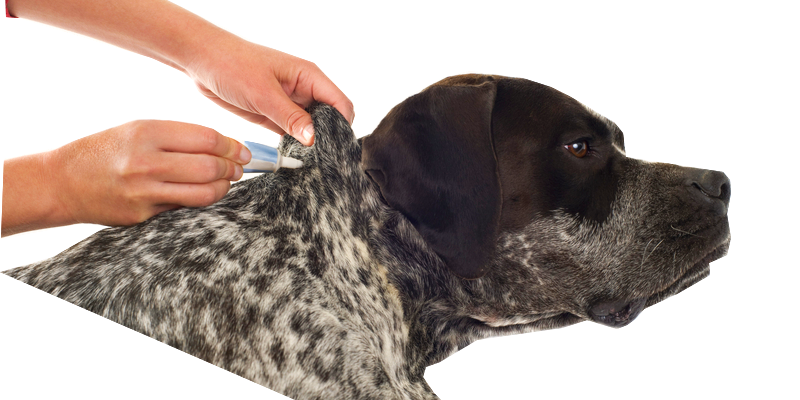Flea and Tick Control

PLENTY OF DISEASES TRANSMITTED
Fleas and ticks probably cause more discomfort and disease in dogs and cats than any other parasite. Fleas easily transmit tapeworms to dogs and cats. Ticks transmit a myriad of diseases (tick borne) such as:
Fleas and ticks are not just a dog or cat problem but also a people problem. Animals can pick up fleas and ticks in the environment and bring them back to their owners while sitting on their laps or sleeping in their beds. Ticks that transmit Lyme Disease to people and dogs are in the larval form. The larval form of the parasite is very difficult to see as it is quite small. This image illustrates how small these ticks are when compared to a dime:
HOW DO THESE PARASITES WORK?
A parasite is an organism that benefits from its host but gives nothing positive in return. Fleas and ticks fit this bill. Before we can talk about flea and tick control, we have to talk about the life cycle and where these parasites usually live. You have to know and understand your enemy!
Insects have four phases of development which can be seen in the above drawing:
- Egg
- Larvae
- Pupae
- Adult
All insects have the same life cycle. In the case of fleas and ticks, moisture is king. Without water there is no life. The eastern third of the United States from the Mississippi River east is extremely wet and humid. Here you will find huge populations of mosquitoes, ticks and fleas. Out in the western states, it is much drier and the flea population is much smaller. There are so many species of ticks that they can be found just about anywhere but nothing compared to the northern tier of the U.S. The southeastern states also have a high tick population.
Dogs and cats pick up fleas from other animals. Those animals may not only be domestic but wild also!! Any mammal can carry fleas. Fleas are blood suckers and do not care what species of animal gets bit. Even this blood sucking is dangerous. It can cause a flea anemia and severely debilitate any young animal. In the dog, fleas are normally found on the posterior part of the back and in the groin area. They can be anywhere but those are the “hot spots”. Fleas only spend a fraction of the time on a dog. They get their blood meal and fall off. When they bite the dog some of its saliva penetrates the animals skin. This saliva contains a protein and it is this protein that makes a dog itch and scratch for hours. A sensitive dog only needs the bite of one flea to develop severe flea bite dermatitis. In this case fleas may not be found but the tell tale signs of flea manure are present. I have always told clients to look for something that looks like grains of pepper. This is what flea manure looks like.
Ticks are a different matter. They love to hang out in tall grasses and in deep woods. They have an uncanny ability to smell carbon dioxide around them. Carbon dioxide is the byproduct of respiration (and water) that is given off by people and animals. When a person or pet walks by, the tick will latch on to the individual and get a free ride home. At the same time the female will get her blood meal from her victim and swell up. In the dog, male ticks are usually found in the ear canal. They are much smaller than the female.
WINNING THE WAR ON THE PET
Years ago all that was available for flea and tick control on dogs and cats were shampoos and antiquated collars. Shampoos clean the dog and did kill some fleas but there was no residual action. The next day, the fleas were back. These flea and tick control products are no longer effective compared to the newer products available today.
There are oral and topical flean and tick control products available today. Some of the topical products are similar in that they have chemical derivatives comparable to a competitor’s product. One of the best drugs to get into your cat or dog for an immediate kill of all fleas is Capstar®. It starts working in about half an hour and kills the majority of fleas in a few hours. Follow up can than be with an oral or topical flea and tick control product.
In 1996, there were just two flea and tick control products to choose from; Frontline® and Program®. Today there probably are about 50 or more with each claiming to be the best flea and tick control product on the market. With a lot of products available, what is the best approach in finding one that works for your lifestyle? Ask your veterinarian which flea and tick control products he or she recommends. Each practice will use something a bit different. Many practices today subscribe to an online store where their customers can purchase a recommended product. ConsumerSearch® has a very good comparison site for flea and tick products.
If you own a cat be careful when choosing a flea and tick control product. DO NOT purchase sprays or products containing permethrins! They produce neurological signs of ataxiaThis term is a condition found in many disease processes. It is an unstable state where the animal staggers around and is unable to ambulate normally. It is usually associated with the neurological system. and tremors when applied to cats. Cats are very very sensitive to a lot of drugs. If you are unsure, contact your veterinarian for his opinion.
OKAY! You are all probably wondering what are MY favorite flea and tick control products over the years. I have not tried each and every product on the market. That is an impossible task to perform. However, I have found products that do work and have done so on many different and distinct flea problems on dogs and cats; even with new derivations that have hit the market. If it works in South Florida, it’ll work anywhere else. Here goes!
- Medium/Large Dog Flea Control: Comfortis®
- Medium/Large Dog Flea/Tick Control: Frontline® Plus
- Small Dog Flea/Tick Control: Revolution®
- Exclusive Dog Tick Control: Frontline® Plus
- Cat Flea/Tick Control: Revolution®
- Huge Cat/Dog flea population and need immediate help: Capstar®
Be aware, that Revolution® also prevents heartworm disease in dogs and cats.


